When it comes to rock drilling, the choice of drill bit is paramount to a project’s success. Specifically, the shape of the carbide button inserts plays a crucial role in determining performance. This article will delve into the two most common types: ballistic and spherical buttons, helping you understand their unique characteristics and applications.
Selecting the correct button shape can significantly impact your drilling speed, bit life, and overall cost-efficiency. We’ll explore how the geometry of each button type interacts with different rock formations, enabling you to make an informed decision for your next project and achieve optimal results.
What are Drill Bit Buttons?

Rock drill bit buttons are the primary cutting elements of a drill bit, specifically designed for breaking and penetrating rock formations. These buttons, typically made from highly durable and wear-resistant materials like cemented tungsten carbide, are embedded into the steel body of the bit. Their shape, size, and arrangement are critical factors that directly influence the bit’s performance, including its drilling speed, lifespan, and suitability for different types of rock.
These buttons are essential components that bear the brunt of the impact and abrasion during drilling.
- Cutting Action: They are responsible for the physical fragmentation of rock, either by crushing or chipping the rock face as the bit rotates and strikes it.
- Durability: Their extreme hardness and wear resistance protect the bit body and ensure a longer service life, even in highly abrasive conditions.
- Versatility: Various shapes—such as spherical, ballistic, or conical—are used to optimize the bit for specific applications, ranging from drilling in soft rock to hard, abrasive rock.
- Efficiency: The strategic placement and configuration of these buttons are designed to maximize drilling efficiency and penetration rate while minimizing energy loss and wear.
Different Button Configurations for Rock Drill Bits
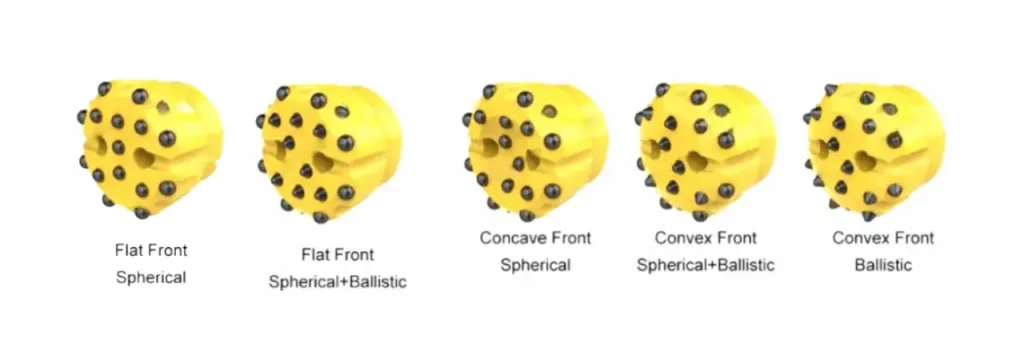
Various rock drill bit designs incorporate different button configurations to optimize drilling performance in specific geological conditions. The combination of face design and button shape significantly impacts penetration rate, bit life, and overall drilling efficiency. Understanding these variations allows for informed bit selection, leading to improved productivity and reduced operational costs.
Flat Front – Spherical Buttons
Flat front drill bits with spherical buttons offer a robust and versatile solution for a wide range of rock formations. The flat face provides stability and even distribution of impact force across the buttons. Spherical buttons, with their rounded shape, are highly resistant to wear and chipping, making them ideal for hard and abrasive rock types. This configuration typically provides a good balance between penetration speed and bit longevity, making it a popular choice for general-purpose drilling applications.
The even wear characteristics of spherical buttons on a flat-faced bit contribute to maintaining a consistent gauge diameter throughout the drilling process. This is particularly advantageous in applications where hole accuracy and straightness are critical. While the penetration rate might not be as aggressive as some other designs in softer rock, the durability and reliability of flat front bits with spherical buttons make them a cost-effective option for many drilling projects.
Flat Front – Spherical + Ballistic Buttons
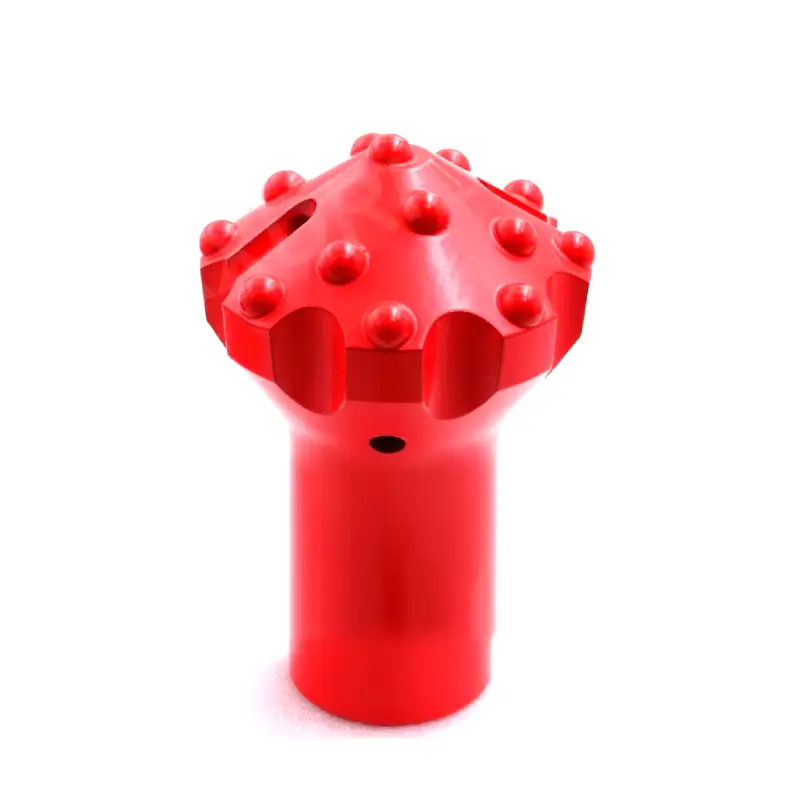
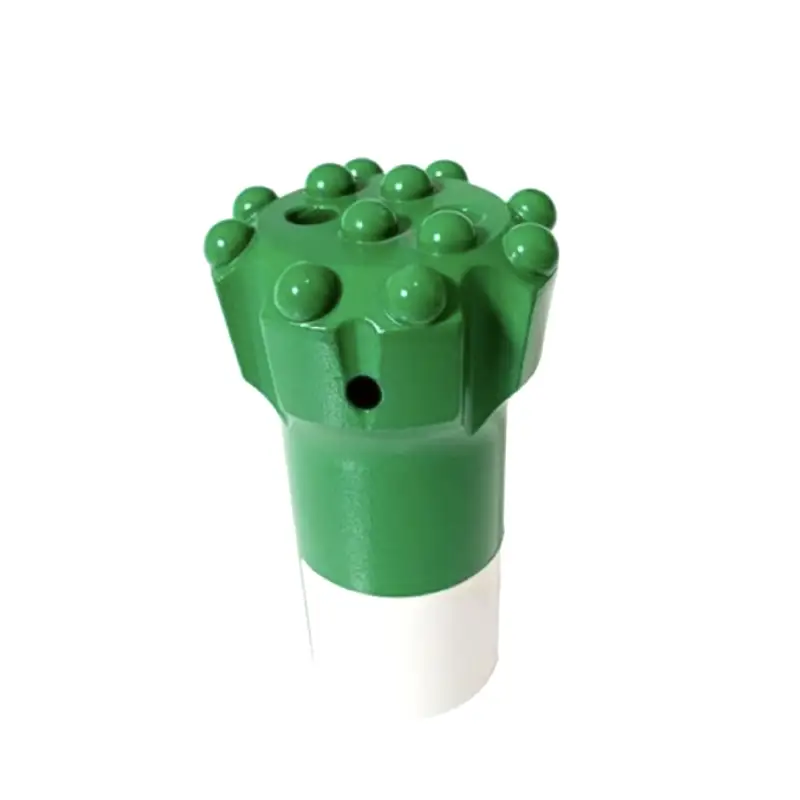
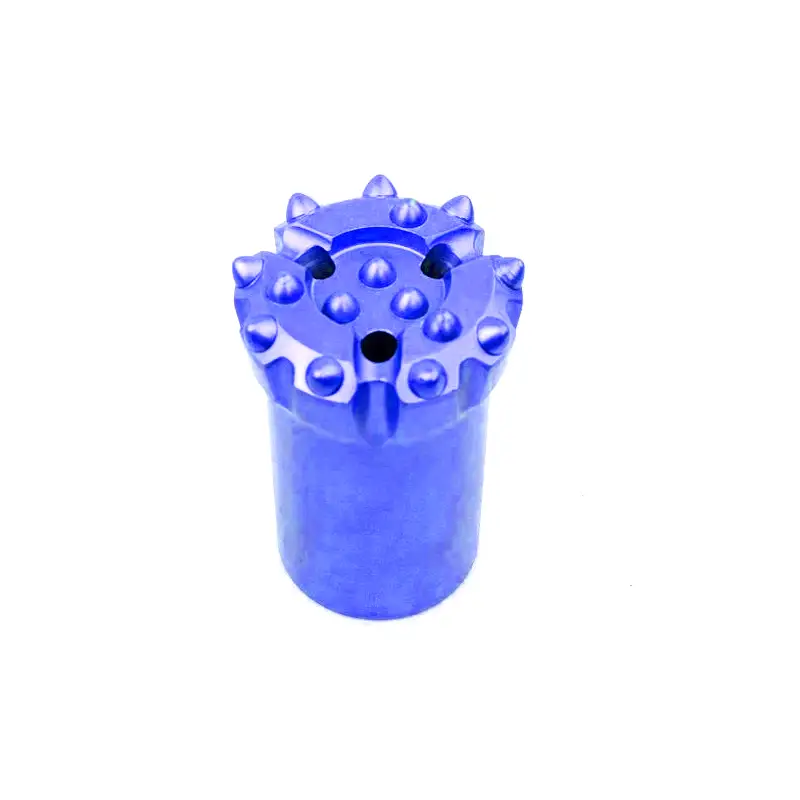
Combining spherical and ballistic buttons on a flat front bit aims to leverage the strengths of both button types. The spherical buttons, typically placed on the gauge row and in areas prone to higher wear, provide excellent durability and maintain hole diameter. The more pointed ballistic buttons, often positioned in the center of the bit face, are designed for faster penetration by focusing impact energy on a smaller contact area.
This hybrid drill bit button configuration is particularly effective in formations that exhibit varying degrees of hardness and abrasiveness. The ballistic buttons initiate fracturing efficiently, while the spherical buttons ensure the bit maintains its gauge and resists wear on the periphery. This combination can lead to improved penetration rates compared to solely spherical buttons, without significantly compromising the bit’s overall lifespan in moderately abrasive conditions.
Concave Front – Spherical Buttons
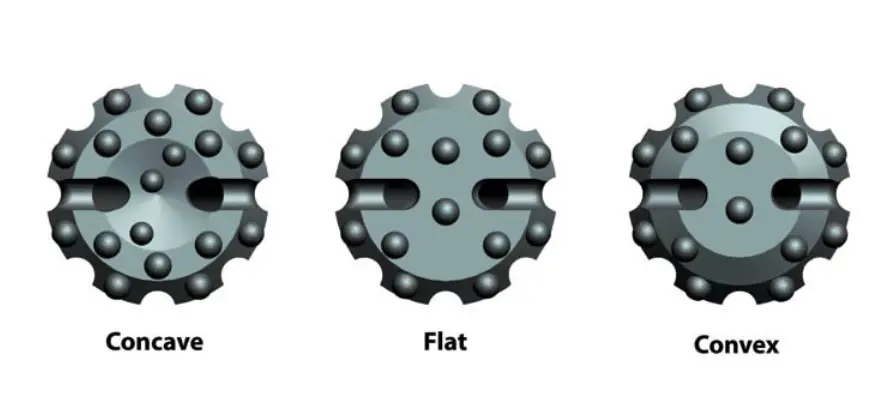
Concave front drill bits with spherical buttons are designed to enhance penetration rates, particularly in softer to medium-hard rock formations. The concave face profile concentrates the impact energy towards the center of the bit, promoting more efficient rock fracturing. Spherical buttons, while offering good wear resistance, work effectively with the concave face to create a focused crushing action in the central area of the borehole.
The concave design also aids in chip removal by directing cuttings towards the flushing holes located in the center of the bit. This improved flushing action helps to maintain a clean drilling face, further contributing to faster penetration. While concave faced bits may offer higher penetration in certain rock types, they might be more susceptible to wear on the gauge row compared to flat-faced bits, especially in highly abrasive conditions.
Convex Front – Spherical + Ballistic Buttons
Convex front drill bits combining spherical and ballistic buttons are engineered for challenging drilling conditions, often involving fractured or uneven rock formations. The convex face design helps to stabilize the bit and reduce the risk of deviation by providing multiple contact points with the rock surface.5 The spherical buttons on the gauge row ensure good wear resistance and maintain hole diameter, while the ballistic buttons positioned centrally facilitate faster penetration through fracturing.
This configuration offers a balance of stability, penetration, and durability. The convex face allows the bit to navigate irregularities in the rock, while the combination of button shapes optimizes both rock fracturing and wear resistance. These bits are often used in demanding applications where maintaining a straight borehole and achieving a reasonable penetration rate are both critical.
Convex Front – Ballistic Buttons
Convex front drill bits featuring exclusively ballistic buttons are designed for aggressive penetration in softer, less abrasive rock formations. The convex face provides bit stability, while the sharp, pointed ballistic buttons concentrate impact energy for efficient rock fracturing. This combination typically results in high penetration rates, making it suitable for applications where speed is a primary concern.
However, the pointed shape of ballistic buttons makes them more susceptible to wear and chipping in hard or highly abrasive rock. Therefore, this bit type is best suited for conditions where the rock is relatively soft and consistent. The convex face, while aiding in stability, works with the aggressive cutting action of the ballistic buttons to achieve rapid drilling progress in appropriate geological environments.
| Feature | Flat Front Spherical | Flat Front Spherical + Ballistic | Concave Front Spherical | Convex Front Spherical + Ballistic | Convex Front Ballistic |
| Face Design | Flat | Flat | Concave | Convex | Convex |
| Button Shape(s) | Spherical | Spherical + Ballistic | Spherical | Spherical + Ballistic | Ballistic |
| Penetration Rate | Moderate | Moderate to High | High | Moderate to High | High |
| Wear Resistance | High | Moderate to High | Moderate | Moderate to High | Moderate |
| Stability | Good | Good | Moderate | Good to Very Good | Good |
| Rock Type Suitability | Wide Range | Variable Hardness | Soft to Medium-Hard | Fractured, Variable | Soft to Medium |
How to Combine Hybrid Drill Bit Buttons?
Combining hybrid drill bit buttons is a strategic process designed to optimize a bit’s performance for specific geological conditions. This involves a thoughtful arrangement of different button shapes to leverage their unique properties, maximizing both penetration speed and bit durability. The goal is to create a single bit that excels in a variety of drilling scenarios.
Step 1: Analyze Rock Formation
The first step is to thoroughly analyze the rock formation you’ll be drilling. You must determine its hardness, abrasiveness, and whether it is fractured or homogeneous. This critical information dictates which button shapes will be most effective, ensuring the chosen combination directly addresses the challenges of the rock.
For example, a formation with varying hardness requires a versatile button combination. A bit designed with this in mind will have the durability to handle hard, abrasive layers while also having the cutting power to efficiently penetrate softer sections without excessive wear or damage.
Step 2: Select Button Shapes
Based on your analysis, you can select the appropriate button shapes. For instance, spherical buttons are chosen for their superior wear resistance, making them ideal for the gauge row. Ballistic buttons, with their more pointed profile, are selected for their aggressive cutting action and are typically placed in the center.
The strategic placement of these buttons is key to the hybrid design. The durable spherical buttons protect the bit’s circumference, maintaining the hole’s diameter. At the same time, the ballistic buttons in the core of the bit maximize the penetration rate, balancing longevity with drilling speed.
Step 3: Configure Button Placement
The final step is to configure the exact placement of the buttons on the bit face. This involves deciding the number of each button type and their specific positions. The goal is to create a balanced cutting action that prevents uneven wear and maintains bit stability throughout the drilling process.
This meticulous arrangement ensures the bit operates at peak efficiency. By carefully distributing the cutting load, the hybrid design prevents premature failure of any single button type. The result is a high-performance bit that offers both the speed and durability needed for complex projects.
Conclusion
Ultimately, the choice between ballistic and spherical button drill bits depends entirely on the specific demands of your project. Spherical buttons offer a robust solution for hard, abrasive rock, providing excellent durability and a longer service life. Ballistic buttons, with their more aggressive shape, are the ideal choice for maximizing penetration speed in softer, less fractured rock. Understanding these differences is key to optimizing your drilling operations and achieving superior results.
By making the right choice, you can dramatically improve your drilling efficiency and reduce your operational costs. Whether you prioritize speed or longevity, selecting a bit that is perfectly matched to your geological conditions is a critical investment in your project’s success. This strategic decision directly impacts your productivity and overall profitability, making it a crucial part of project planning.
For all your drilling needs, we encourage you to explore our extensive range of high-quality button drill bits. You can get wholesale button drill bits from our Sinodrills, where we offer a wide selection of both ballistic and spherical designs. Our expert team is ready to assist you in selecting the perfect bit to ensure your project runs smoothly and efficiently.


